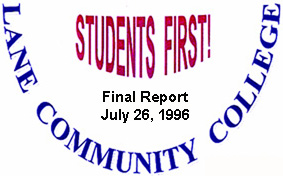| Lane Home Page | Search Lane |
| Website Accessibility |
|
Table of Contents | Main Students First! Page Lane Community College (Lane) needs to improve services to students now. This assertion may be initially puzzling, in light of how well Lane is perceived by its students. In fact, most Lane students think very favorably of the College. In a telephone survey of a random representative sample of current students conducted in May 1996, fully ninety-four percent of respondents said they would recommend Lane to a friend, and sixty-eight percent said they are very satisfied with Lane services. Why then does Lane need to improve services to students now? There are several compelling reasons to take action at this time. First, while students report high levels of satisfaction, employees tell a different story. Eighty-five percent of administrative employees surveyed in the summer of 1995 believe that change is needed at Lane. Fully ninety-two percent of employees surveyed believe there is a better way of doing their work, and eighty-two percent believe their job satisfaction will be increased by improving work processes. In group sessions held with administrative employees in the summer of 1996, employees frequently expressed the belief that they worked within overly complex processes and policies, and a significant part of their efforts were expended in performing tasks for students in order to protect them from these complex, and often unnecessary, processes and policies. In other words, employees are 'buffering' students from inefficient and unnecessary processes. Employee resources are not being utilized as effectively and productively as possible. This situation is unsustainable: over time, it will lead to increased job dissatisfaction, employee burn-out, unnecessary costs, and ultimately, attrition. Second, student expectations are changing. Sixty-four percent of Lane students are over 25 years of age. Sixty percent of Lane students work for pay, and over half work full time. Lane students are older and more sophisticated in their expectations of service providers than traditional students. They have limited time, and need to be served quickly and efficiently to remain satisfied 'customers' of educational services. Third, the higher education marketplace is increasingly competitive. Many higher education institutions that formerly focused on traditional degree programs are branching out into continuing education as a potential source of additional revenue. Private corporations and individual professionals are increasingly offering adult education and training programs. With the advent of distance learning technologies, adults have more volume and variety of alternatives for higher education opportunities than ever before. If Lane does not meet, and exceed, the needs of its students, students will go elsewhere for higher education services. Related to this increased competition, many higher education institutions are undergoing service improvement and transformation efforts. Advances in technology are enabling institutions to provide students with more flexible and convenient access to services and information than ever before. Lane needs to stay ahead of the curve and offer similar access to services and information, or again, students will go elsewhere. Fourth, if current patterns of state funding in higher education continue, Lane may be facing an impending budget shortfall. Proactive cost containment efforts are necessary now to ensure that Lane can devote adequate resources to its instructional mission, and apply its administrative support resources as efficiently as possible. Finally, Lane faces a unique window of opportunity to invest in improving services to students now. Lane County citizens voted in May of 1995 to support a $42.8 million construction bond measure for expanding and improving Lane's physical plant. Eighty-five percent of these moneys must be spent by June of 1998. Since improving services to students will require that Lane provide students with greater convenience in physical access to services, this bond funding is a critical element in student service improvement. Lane has just completed an intensive evaluation of how services to students can be improved. This report details the findings and recommendations resulting from that Students First! Redesign effort. It should be considered a progress report, for Lane will be involved in improvement and transformation of services to students on a continuous basis, if it is to adequately address the forces described above. Lane is now entering an implementation phase in which it will be devoting attention and resources to the implementation of the recommendations resulting from the research and evaluation process. Lane anticipates that implementation of the recommendations described in this report will be phased in over the next one to two years. Lane intends to incorporate process redesign efforts like this one as an ongoing way of doing business. The Students First! Redesign project, as the first such project at Lane, will serve as both a pilot and a model for future projects. In addition to services to students, planning and budgeting, personnel, grants and contracts, procurement, and financial transactions will undergo redesign in the future. Ongoing process redesign is the only way that Lane will be able to sustain the high satisfaction levels of students that it currently enjoys, and meet the demands of a rapidly changing environment.
|
>> Return to Lane's Home Page >> Return to Process Redesign Project Main Page >> Return to top of page Lane Community College - Process Redesign Project 4000 East 30th Avenue, Eugene, OR 97405 Please direct comments about this site to webmaster@lanecc.edu Revised 12/2/96 (llb) © 1996-present Lane Community College |

